Tuberous Sclerosis: Neuropsychiatric Comorbidities in Children Study
VerifiedAdded on 2023/06/15
|11
|2535
|432
Report
AI Summary
This study investigates the frequency of neuropsychiatric comorbidities such as ASD, ADHD, and OCD in children with Tuberous Sclerosis (TS) using a retrospective cohort study approach. Data was collected from clinic reports of 67 children diagnosed with TS, focusing on the prevalence of mental retardation, ASD, and other psychopathologies. The results indicate that approximately half of the children with TS also experience mental retardation, while a smaller percentage is diagnosed with ASD. The study also explores the use of psychiatric drugs in managing these conditions, highlighting the importance of demographic data in understanding the prevalence and management of comorbid disorders in children with TS. The data indicates that antipsychotics were more commonly used than antidepressants. The study concludes that while TS patients may exhibit other neurological disorders, not all cases lead to ASD, emphasizing the need for tailored management strategies.
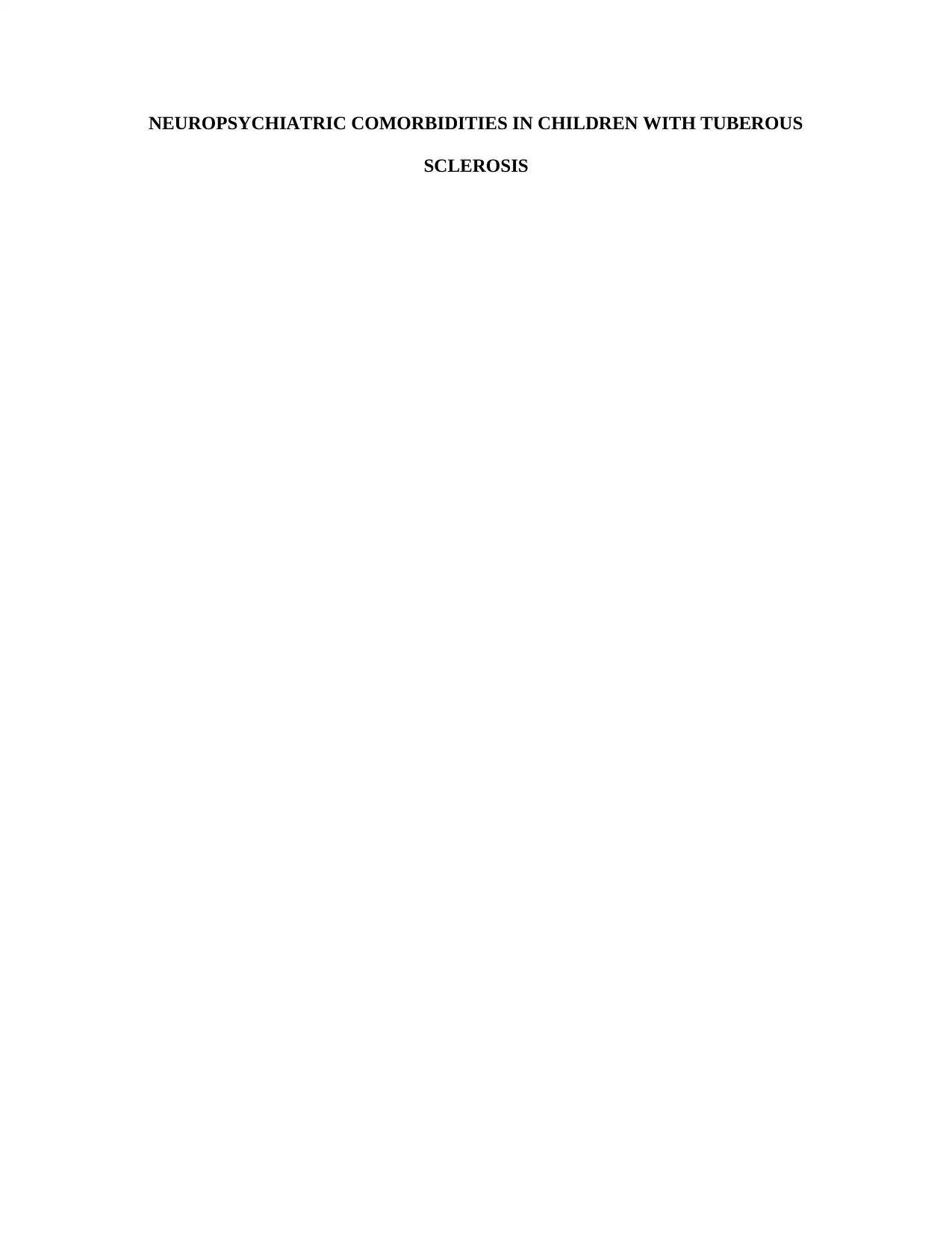
NEUROPSYCHIATRIC COMORBIDITIES IN CHILDREN WITH TUBEROUS
SCLEROSIS
SCLEROSIS
Paraphrase This Document
Need a fresh take? Get an instant paraphrase of this document with our AI Paraphraser
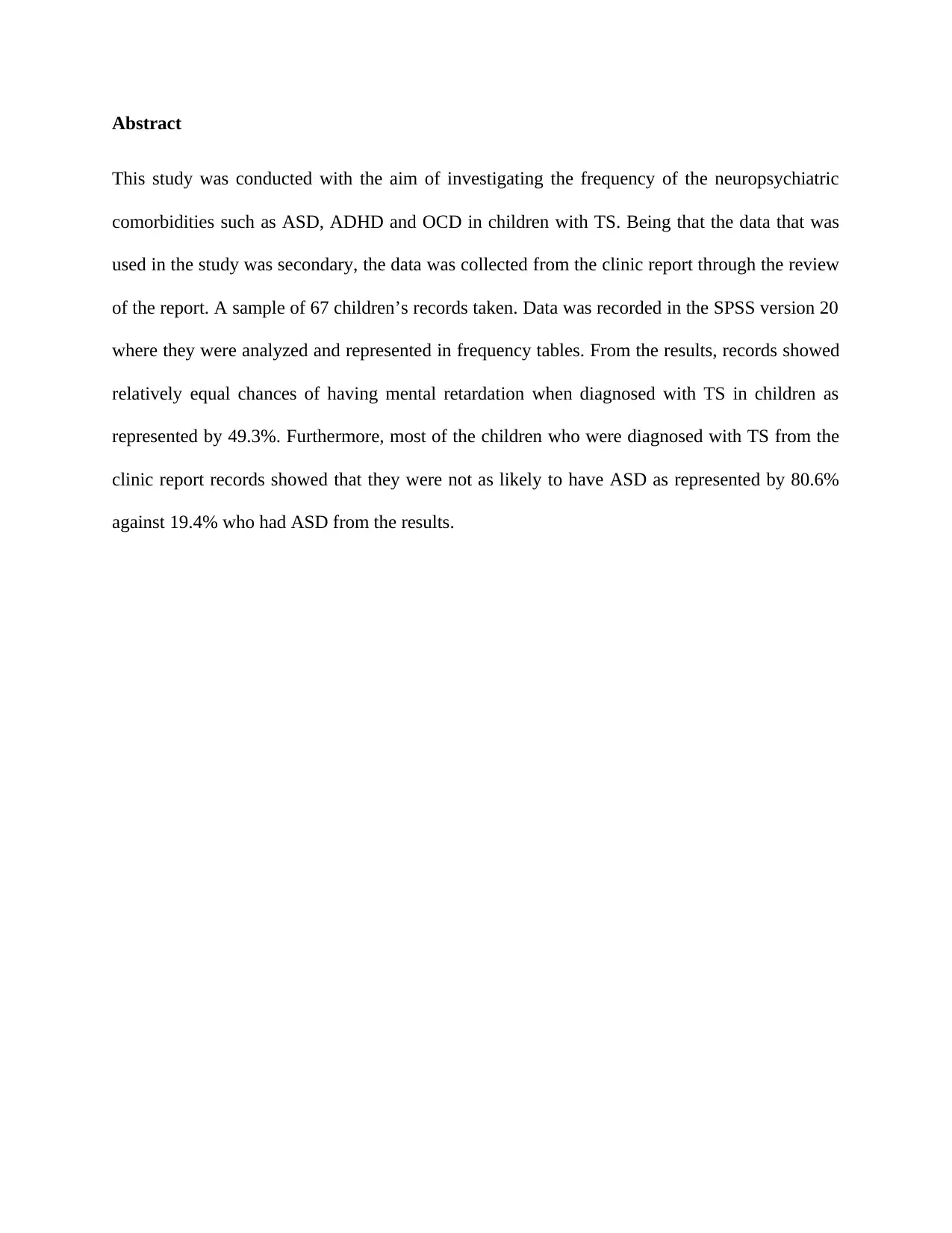
Abstract
This study was conducted with the aim of investigating the frequency of the neuropsychiatric
comorbidities such as ASD, ADHD and OCD in children with TS. Being that the data that was
used in the study was secondary, the data was collected from the clinic report through the review
of the report. A sample of 67 children’s records taken. Data was recorded in the SPSS version 20
where they were analyzed and represented in frequency tables. From the results, records showed
relatively equal chances of having mental retardation when diagnosed with TS in children as
represented by 49.3%. Furthermore, most of the children who were diagnosed with TS from the
clinic report records showed that they were not as likely to have ASD as represented by 80.6%
against 19.4% who had ASD from the results.
This study was conducted with the aim of investigating the frequency of the neuropsychiatric
comorbidities such as ASD, ADHD and OCD in children with TS. Being that the data that was
used in the study was secondary, the data was collected from the clinic report through the review
of the report. A sample of 67 children’s records taken. Data was recorded in the SPSS version 20
where they were analyzed and represented in frequency tables. From the results, records showed
relatively equal chances of having mental retardation when diagnosed with TS in children as
represented by 49.3%. Furthermore, most of the children who were diagnosed with TS from the
clinic report records showed that they were not as likely to have ASD as represented by 80.6%
against 19.4% who had ASD from the results.
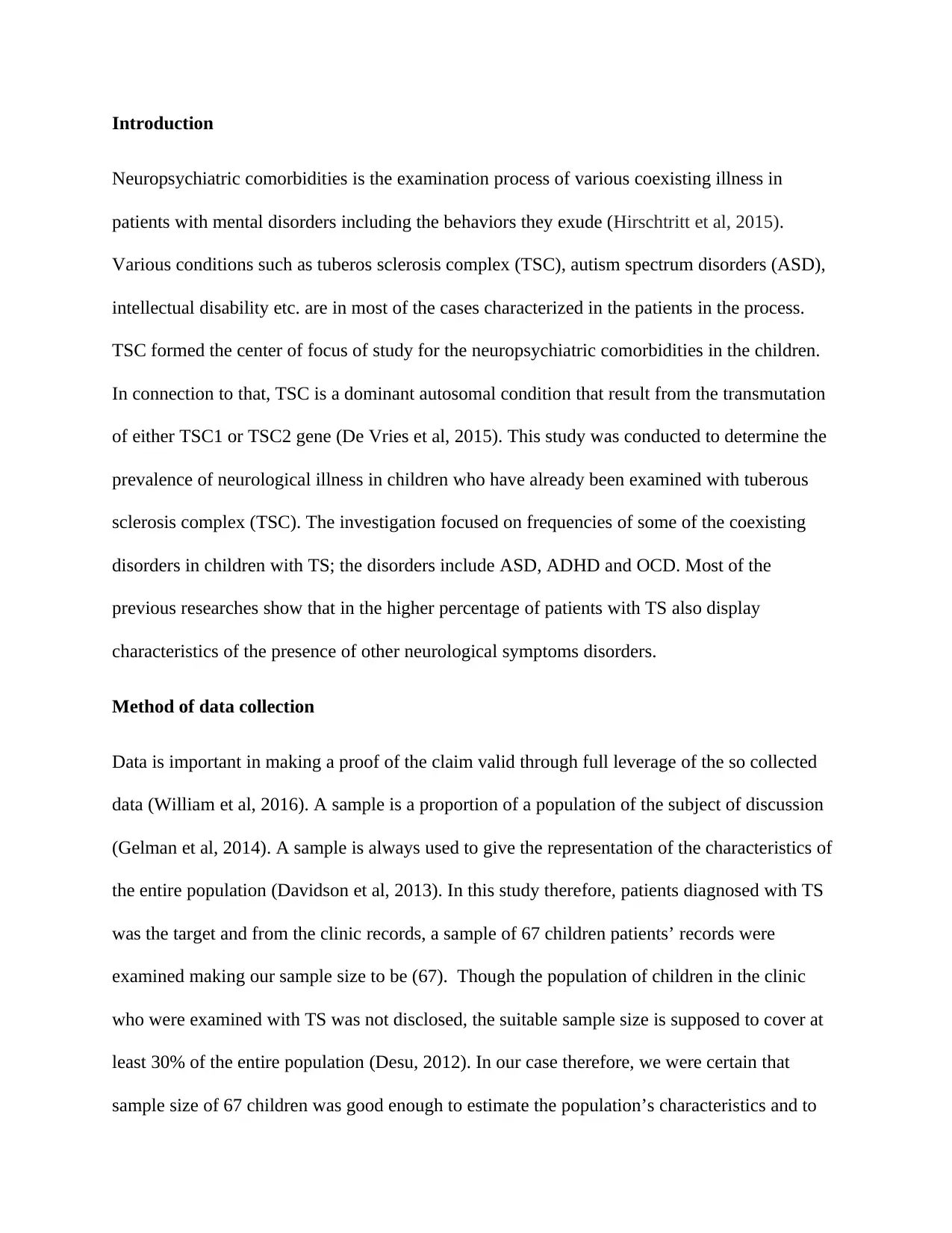
Introduction
Neuropsychiatric comorbidities is the examination process of various coexisting illness in
patients with mental disorders including the behaviors they exude (Hirschtritt et al, 2015).
Various conditions such as tuberos sclerosis complex (TSC), autism spectrum disorders (ASD),
intellectual disability etc. are in most of the cases characterized in the patients in the process.
TSC formed the center of focus of study for the neuropsychiatric comorbidities in the children.
In connection to that, TSC is a dominant autosomal condition that result from the transmutation
of either TSC1 or TSC2 gene (De Vries et al, 2015). This study was conducted to determine the
prevalence of neurological illness in children who have already been examined with tuberous
sclerosis complex (TSC). The investigation focused on frequencies of some of the coexisting
disorders in children with TS; the disorders include ASD, ADHD and OCD. Most of the
previous researches show that in the higher percentage of patients with TS also display
characteristics of the presence of other neurological symptoms disorders.
Method of data collection
Data is important in making a proof of the claim valid through full leverage of the so collected
data (William et al, 2016). A sample is a proportion of a population of the subject of discussion
(Gelman et al, 2014). A sample is always used to give the representation of the characteristics of
the entire population (Davidson et al, 2013). In this study therefore, patients diagnosed with TS
was the target and from the clinic records, a sample of 67 children patients’ records were
examined making our sample size to be (67). Though the population of children in the clinic
who were examined with TS was not disclosed, the suitable sample size is supposed to cover at
least 30% of the entire population (Desu, 2012). In our case therefore, we were certain that
sample size of 67 children was good enough to estimate the population’s characteristics and to
Neuropsychiatric comorbidities is the examination process of various coexisting illness in
patients with mental disorders including the behaviors they exude (Hirschtritt et al, 2015).
Various conditions such as tuberos sclerosis complex (TSC), autism spectrum disorders (ASD),
intellectual disability etc. are in most of the cases characterized in the patients in the process.
TSC formed the center of focus of study for the neuropsychiatric comorbidities in the children.
In connection to that, TSC is a dominant autosomal condition that result from the transmutation
of either TSC1 or TSC2 gene (De Vries et al, 2015). This study was conducted to determine the
prevalence of neurological illness in children who have already been examined with tuberous
sclerosis complex (TSC). The investigation focused on frequencies of some of the coexisting
disorders in children with TS; the disorders include ASD, ADHD and OCD. Most of the
previous researches show that in the higher percentage of patients with TS also display
characteristics of the presence of other neurological symptoms disorders.
Method of data collection
Data is important in making a proof of the claim valid through full leverage of the so collected
data (William et al, 2016). A sample is a proportion of a population of the subject of discussion
(Gelman et al, 2014). A sample is always used to give the representation of the characteristics of
the entire population (Davidson et al, 2013). In this study therefore, patients diagnosed with TS
was the target and from the clinic records, a sample of 67 children patients’ records were
examined making our sample size to be (67). Though the population of children in the clinic
who were examined with TS was not disclosed, the suitable sample size is supposed to cover at
least 30% of the entire population (Desu, 2012). In our case therefore, we were certain that
sample size of 67 children was good enough to estimate the population’s characteristics and to
⊘ This is a preview!⊘
Do you want full access?
Subscribe today to unlock all pages.

Trusted by 1+ million students worldwide
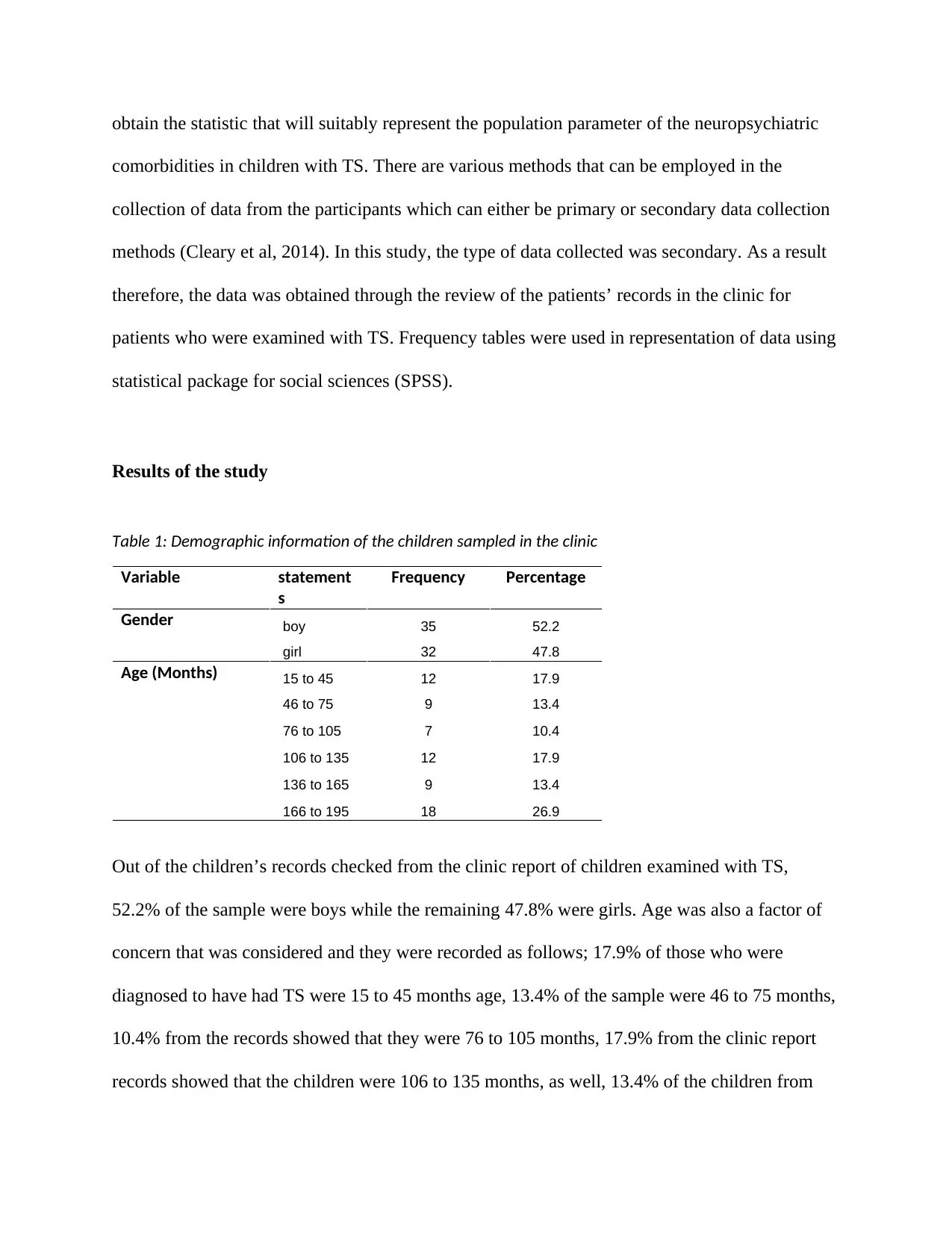
obtain the statistic that will suitably represent the population parameter of the neuropsychiatric
comorbidities in children with TS. There are various methods that can be employed in the
collection of data from the participants which can either be primary or secondary data collection
methods (Cleary et al, 2014). In this study, the type of data collected was secondary. As a result
therefore, the data was obtained through the review of the patients’ records in the clinic for
patients who were examined with TS. Frequency tables were used in representation of data using
statistical package for social sciences (SPSS).
Results of the study
Table 1: Demographic information of the children sampled in the clinic
Variable statement
s
Frequency Percentage
Gender boy 35 52.2
girl 32 47.8
Age (Months) 15 to 45 12 17.9
46 to 75 9 13.4
76 to 105 7 10.4
106 to 135 12 17.9
136 to 165 9 13.4
166 to 195 18 26.9
Out of the children’s records checked from the clinic report of children examined with TS,
52.2% of the sample were boys while the remaining 47.8% were girls. Age was also a factor of
concern that was considered and they were recorded as follows; 17.9% of those who were
diagnosed to have had TS were 15 to 45 months age, 13.4% of the sample were 46 to 75 months,
10.4% from the records showed that they were 76 to 105 months, 17.9% from the clinic report
records showed that the children were 106 to 135 months, as well, 13.4% of the children from
comorbidities in children with TS. There are various methods that can be employed in the
collection of data from the participants which can either be primary or secondary data collection
methods (Cleary et al, 2014). In this study, the type of data collected was secondary. As a result
therefore, the data was obtained through the review of the patients’ records in the clinic for
patients who were examined with TS. Frequency tables were used in representation of data using
statistical package for social sciences (SPSS).
Results of the study
Table 1: Demographic information of the children sampled in the clinic
Variable statement
s
Frequency Percentage
Gender boy 35 52.2
girl 32 47.8
Age (Months) 15 to 45 12 17.9
46 to 75 9 13.4
76 to 105 7 10.4
106 to 135 12 17.9
136 to 165 9 13.4
166 to 195 18 26.9
Out of the children’s records checked from the clinic report of children examined with TS,
52.2% of the sample were boys while the remaining 47.8% were girls. Age was also a factor of
concern that was considered and they were recorded as follows; 17.9% of those who were
diagnosed to have had TS were 15 to 45 months age, 13.4% of the sample were 46 to 75 months,
10.4% from the records showed that they were 76 to 105 months, 17.9% from the clinic report
records showed that the children were 106 to 135 months, as well, 13.4% of the children from
Paraphrase This Document
Need a fresh take? Get an instant paraphrase of this document with our AI Paraphraser
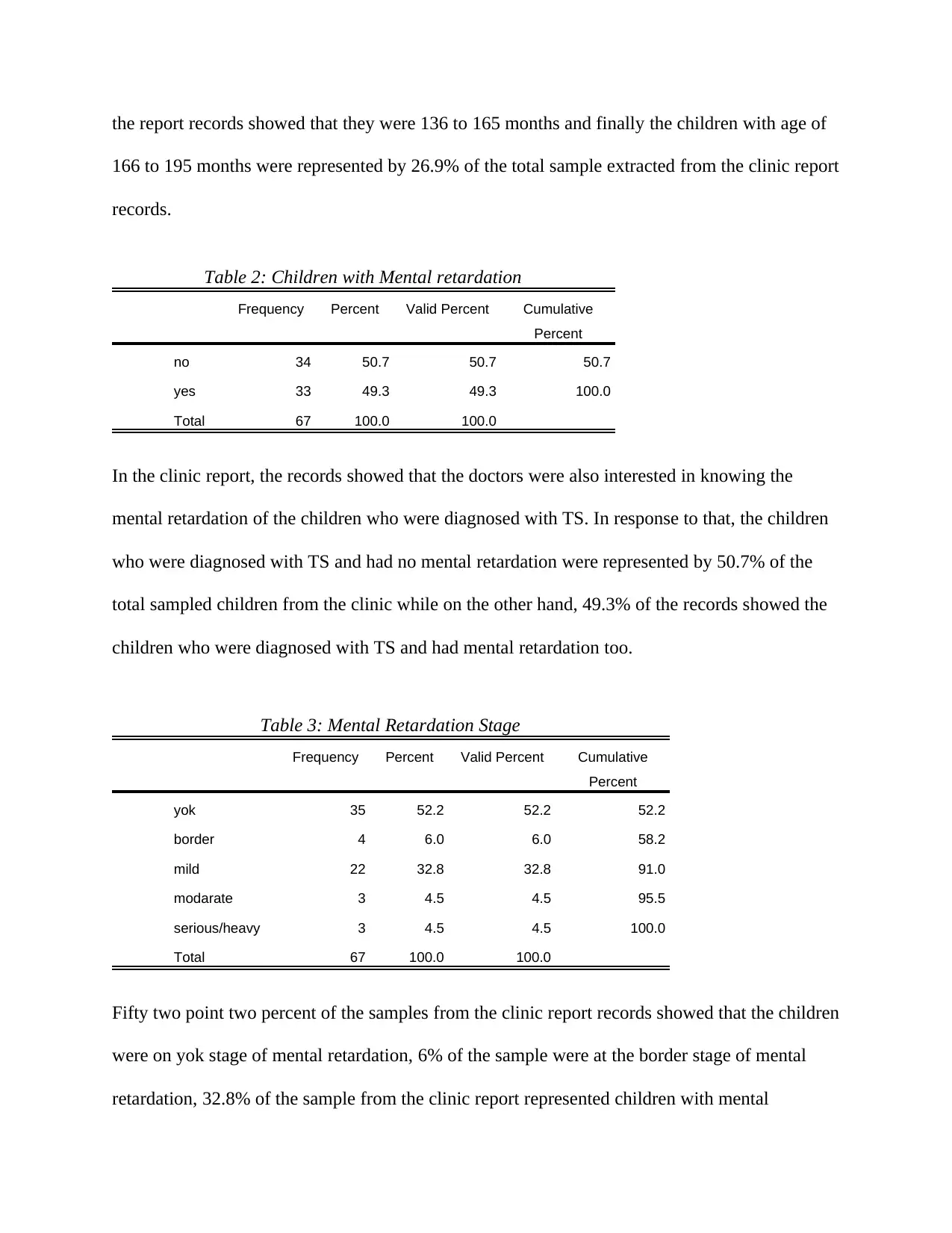
the report records showed that they were 136 to 165 months and finally the children with age of
166 to 195 months were represented by 26.9% of the total sample extracted from the clinic report
records.
Table 2: Children with Mental retardation
Frequency Percent Valid Percent Cumulative
Percent
no 34 50.7 50.7 50.7
yes 33 49.3 49.3 100.0
Total 67 100.0 100.0
In the clinic report, the records showed that the doctors were also interested in knowing the
mental retardation of the children who were diagnosed with TS. In response to that, the children
who were diagnosed with TS and had no mental retardation were represented by 50.7% of the
total sampled children from the clinic while on the other hand, 49.3% of the records showed the
children who were diagnosed with TS and had mental retardation too.
Table 3: Mental Retardation Stage
Frequency Percent Valid Percent Cumulative
Percent
yok 35 52.2 52.2 52.2
border 4 6.0 6.0 58.2
mild 22 32.8 32.8 91.0
modarate 3 4.5 4.5 95.5
serious/heavy 3 4.5 4.5 100.0
Total 67 100.0 100.0
Fifty two point two percent of the samples from the clinic report records showed that the children
were on yok stage of mental retardation, 6% of the sample were at the border stage of mental
retardation, 32.8% of the sample from the clinic report represented children with mental
166 to 195 months were represented by 26.9% of the total sample extracted from the clinic report
records.
Table 2: Children with Mental retardation
Frequency Percent Valid Percent Cumulative
Percent
no 34 50.7 50.7 50.7
yes 33 49.3 49.3 100.0
Total 67 100.0 100.0
In the clinic report, the records showed that the doctors were also interested in knowing the
mental retardation of the children who were diagnosed with TS. In response to that, the children
who were diagnosed with TS and had no mental retardation were represented by 50.7% of the
total sampled children from the clinic while on the other hand, 49.3% of the records showed the
children who were diagnosed with TS and had mental retardation too.
Table 3: Mental Retardation Stage
Frequency Percent Valid Percent Cumulative
Percent
yok 35 52.2 52.2 52.2
border 4 6.0 6.0 58.2
mild 22 32.8 32.8 91.0
modarate 3 4.5 4.5 95.5
serious/heavy 3 4.5 4.5 100.0
Total 67 100.0 100.0
Fifty two point two percent of the samples from the clinic report records showed that the children
were on yok stage of mental retardation, 6% of the sample were at the border stage of mental
retardation, 32.8% of the sample from the clinic report represented children with mental
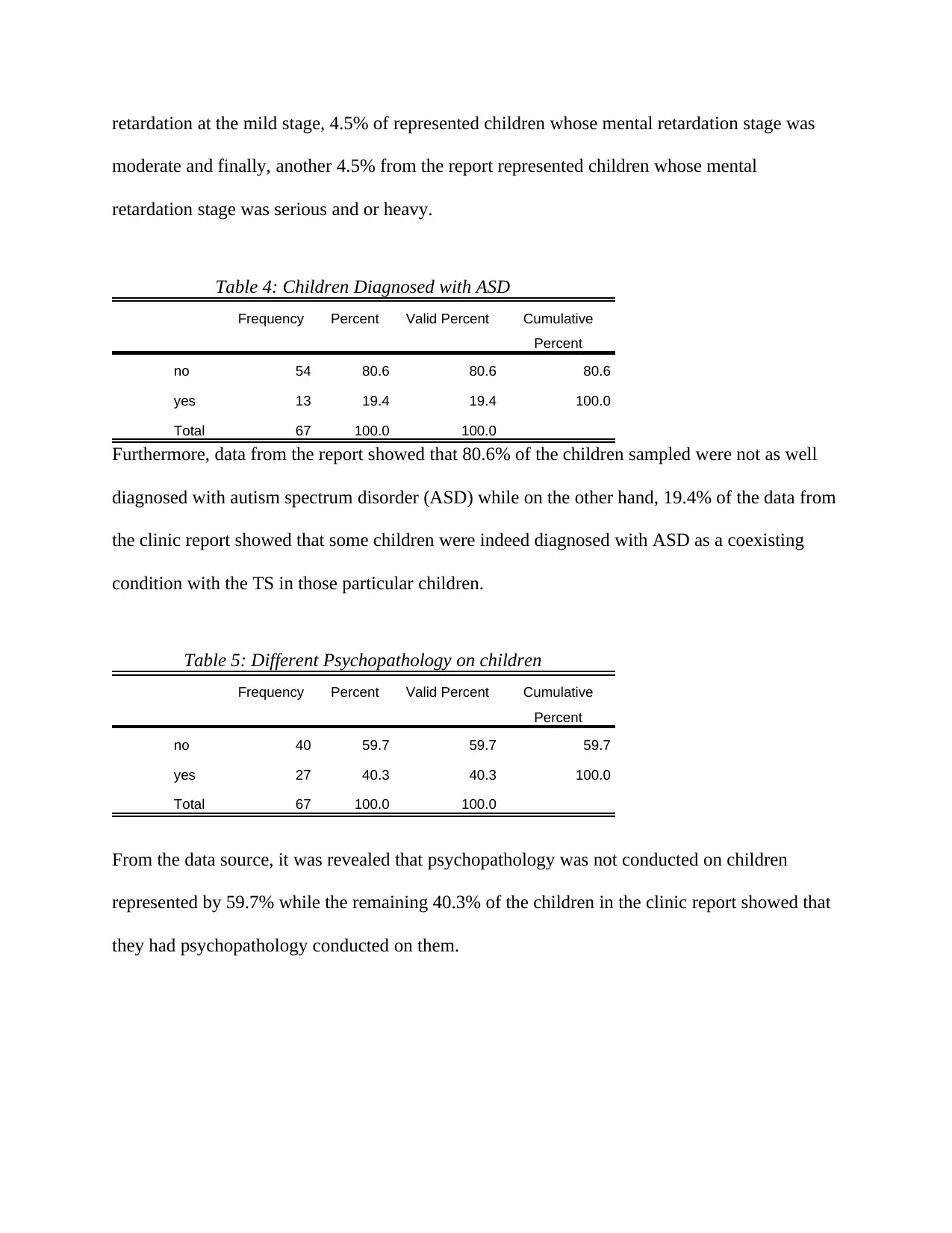
retardation at the mild stage, 4.5% of represented children whose mental retardation stage was
moderate and finally, another 4.5% from the report represented children whose mental
retardation stage was serious and or heavy.
Table 4: Children Diagnosed with ASD
Frequency Percent Valid Percent Cumulative
Percent
no 54 80.6 80.6 80.6
yes 13 19.4 19.4 100.0
Total 67 100.0 100.0
Furthermore, data from the report showed that 80.6% of the children sampled were not as well
diagnosed with autism spectrum disorder (ASD) while on the other hand, 19.4% of the data from
the clinic report showed that some children were indeed diagnosed with ASD as a coexisting
condition with the TS in those particular children.
Table 5: Different Psychopathology on children
Frequency Percent Valid Percent Cumulative
Percent
no 40 59.7 59.7 59.7
yes 27 40.3 40.3 100.0
Total 67 100.0 100.0
From the data source, it was revealed that psychopathology was not conducted on children
represented by 59.7% while the remaining 40.3% of the children in the clinic report showed that
they had psychopathology conducted on them.
moderate and finally, another 4.5% from the report represented children whose mental
retardation stage was serious and or heavy.
Table 4: Children Diagnosed with ASD
Frequency Percent Valid Percent Cumulative
Percent
no 54 80.6 80.6 80.6
yes 13 19.4 19.4 100.0
Total 67 100.0 100.0
Furthermore, data from the report showed that 80.6% of the children sampled were not as well
diagnosed with autism spectrum disorder (ASD) while on the other hand, 19.4% of the data from
the clinic report showed that some children were indeed diagnosed with ASD as a coexisting
condition with the TS in those particular children.
Table 5: Different Psychopathology on children
Frequency Percent Valid Percent Cumulative
Percent
no 40 59.7 59.7 59.7
yes 27 40.3 40.3 100.0
Total 67 100.0 100.0
From the data source, it was revealed that psychopathology was not conducted on children
represented by 59.7% while the remaining 40.3% of the children in the clinic report showed that
they had psychopathology conducted on them.
⊘ This is a preview!⊘
Do you want full access?
Subscribe today to unlock all pages.

Trusted by 1+ million students worldwide
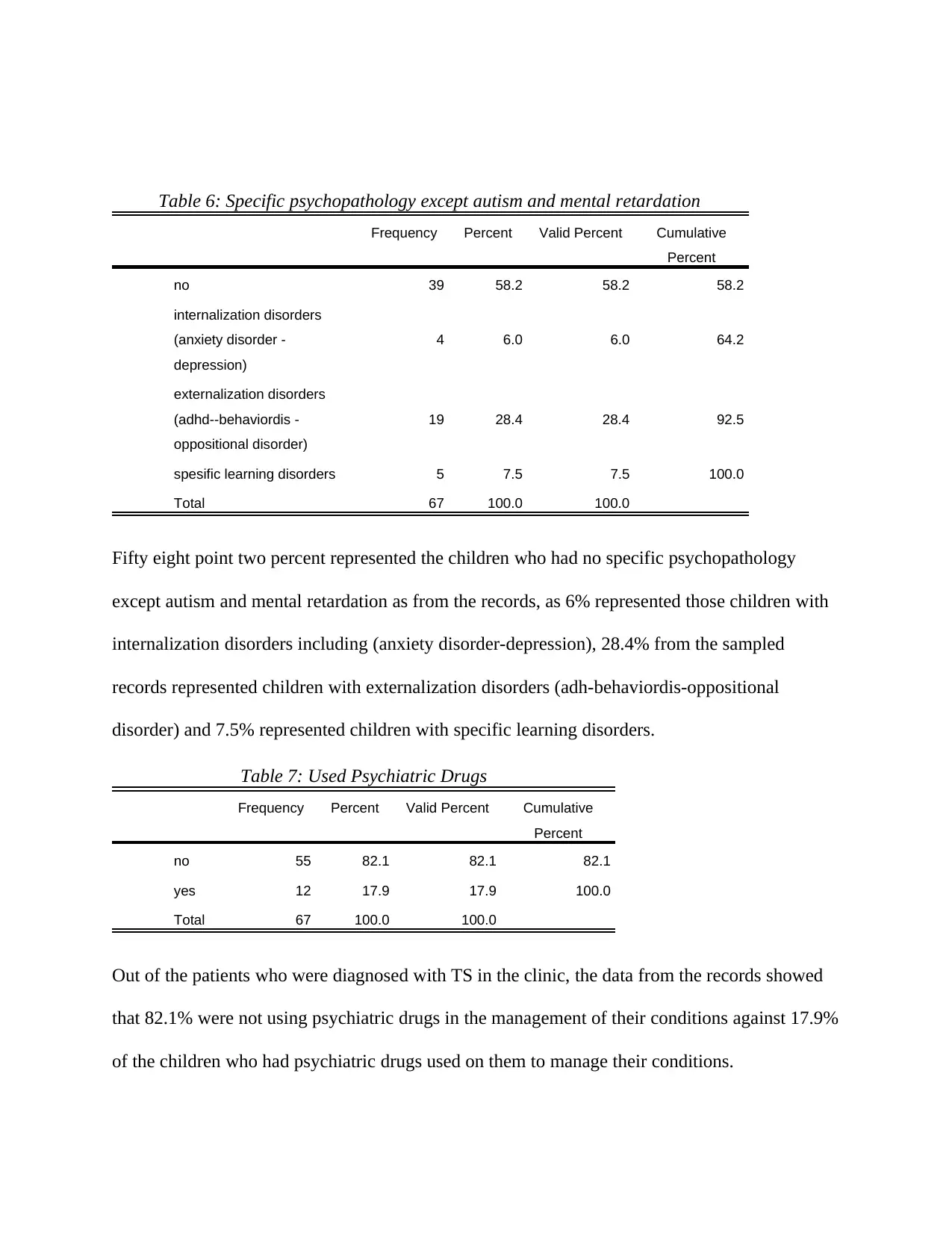
Table 6: Specific psychopathology except autism and mental retardation
Frequency Percent Valid Percent Cumulative
Percent
no 39 58.2 58.2 58.2
internalization disorders
(anxiety disorder -
depression)
4 6.0 6.0 64.2
externalization disorders
(adhd--behaviordis -
oppositional disorder)
19 28.4 28.4 92.5
spesific learning disorders 5 7.5 7.5 100.0
Total 67 100.0 100.0
Fifty eight point two percent represented the children who had no specific psychopathology
except autism and mental retardation as from the records, as 6% represented those children with
internalization disorders including (anxiety disorder-depression), 28.4% from the sampled
records represented children with externalization disorders (adh-behaviordis-oppositional
disorder) and 7.5% represented children with specific learning disorders.
Table 7: Used Psychiatric Drugs
Frequency Percent Valid Percent Cumulative
Percent
no 55 82.1 82.1 82.1
yes 12 17.9 17.9 100.0
Total 67 100.0 100.0
Out of the patients who were diagnosed with TS in the clinic, the data from the records showed
that 82.1% were not using psychiatric drugs in the management of their conditions against 17.9%
of the children who had psychiatric drugs used on them to manage their conditions.
Frequency Percent Valid Percent Cumulative
Percent
no 39 58.2 58.2 58.2
internalization disorders
(anxiety disorder -
depression)
4 6.0 6.0 64.2
externalization disorders
(adhd--behaviordis -
oppositional disorder)
19 28.4 28.4 92.5
spesific learning disorders 5 7.5 7.5 100.0
Total 67 100.0 100.0
Fifty eight point two percent represented the children who had no specific psychopathology
except autism and mental retardation as from the records, as 6% represented those children with
internalization disorders including (anxiety disorder-depression), 28.4% from the sampled
records represented children with externalization disorders (adh-behaviordis-oppositional
disorder) and 7.5% represented children with specific learning disorders.
Table 7: Used Psychiatric Drugs
Frequency Percent Valid Percent Cumulative
Percent
no 55 82.1 82.1 82.1
yes 12 17.9 17.9 100.0
Total 67 100.0 100.0
Out of the patients who were diagnosed with TS in the clinic, the data from the records showed
that 82.1% were not using psychiatric drugs in the management of their conditions against 17.9%
of the children who had psychiatric drugs used on them to manage their conditions.
Paraphrase This Document
Need a fresh take? Get an instant paraphrase of this document with our AI Paraphraser
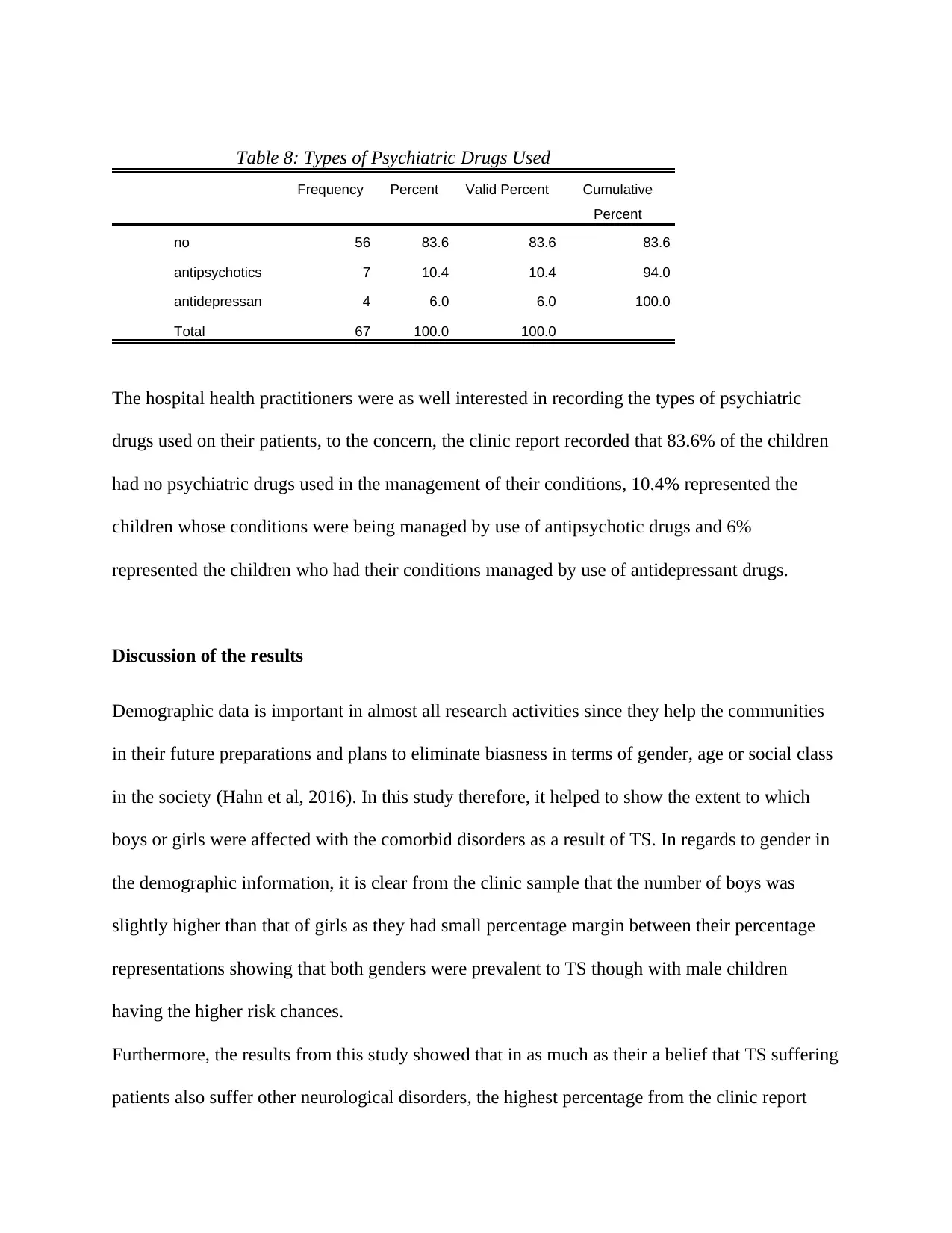
Table 8: Types of Psychiatric Drugs Used
Frequency Percent Valid Percent Cumulative
Percent
no 56 83.6 83.6 83.6
antipsychotics 7 10.4 10.4 94.0
antidepressan 4 6.0 6.0 100.0
Total 67 100.0 100.0
The hospital health practitioners were as well interested in recording the types of psychiatric
drugs used on their patients, to the concern, the clinic report recorded that 83.6% of the children
had no psychiatric drugs used in the management of their conditions, 10.4% represented the
children whose conditions were being managed by use of antipsychotic drugs and 6%
represented the children who had their conditions managed by use of antidepressant drugs.
Discussion of the results
Demographic data is important in almost all research activities since they help the communities
in their future preparations and plans to eliminate biasness in terms of gender, age or social class
in the society (Hahn et al, 2016). In this study therefore, it helped to show the extent to which
boys or girls were affected with the comorbid disorders as a result of TS. In regards to gender in
the demographic information, it is clear from the clinic sample that the number of boys was
slightly higher than that of girls as they had small percentage margin between their percentage
representations showing that both genders were prevalent to TS though with male children
having the higher risk chances.
Furthermore, the results from this study showed that in as much as their a belief that TS suffering
patients also suffer other neurological disorders, the highest percentage from the clinic report
Frequency Percent Valid Percent Cumulative
Percent
no 56 83.6 83.6 83.6
antipsychotics 7 10.4 10.4 94.0
antidepressan 4 6.0 6.0 100.0
Total 67 100.0 100.0
The hospital health practitioners were as well interested in recording the types of psychiatric
drugs used on their patients, to the concern, the clinic report recorded that 83.6% of the children
had no psychiatric drugs used in the management of their conditions, 10.4% represented the
children whose conditions were being managed by use of antipsychotic drugs and 6%
represented the children who had their conditions managed by use of antidepressant drugs.
Discussion of the results
Demographic data is important in almost all research activities since they help the communities
in their future preparations and plans to eliminate biasness in terms of gender, age or social class
in the society (Hahn et al, 2016). In this study therefore, it helped to show the extent to which
boys or girls were affected with the comorbid disorders as a result of TS. In regards to gender in
the demographic information, it is clear from the clinic sample that the number of boys was
slightly higher than that of girls as they had small percentage margin between their percentage
representations showing that both genders were prevalent to TS though with male children
having the higher risk chances.
Furthermore, the results from this study showed that in as much as their a belief that TS suffering
patients also suffer other neurological disorders, the highest percentage from the clinic report
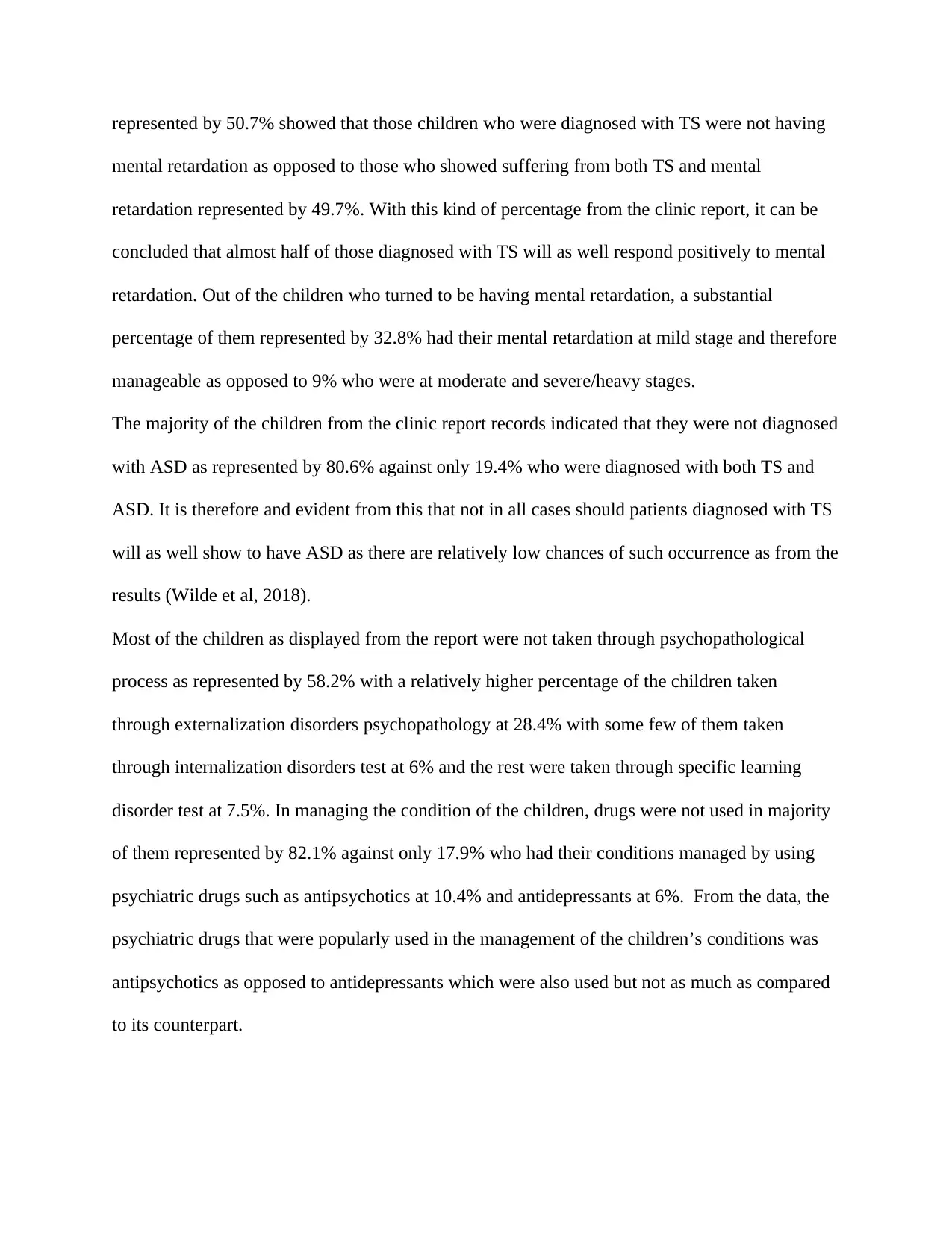
represented by 50.7% showed that those children who were diagnosed with TS were not having
mental retardation as opposed to those who showed suffering from both TS and mental
retardation represented by 49.7%. With this kind of percentage from the clinic report, it can be
concluded that almost half of those diagnosed with TS will as well respond positively to mental
retardation. Out of the children who turned to be having mental retardation, a substantial
percentage of them represented by 32.8% had their mental retardation at mild stage and therefore
manageable as opposed to 9% who were at moderate and severe/heavy stages.
The majority of the children from the clinic report records indicated that they were not diagnosed
with ASD as represented by 80.6% against only 19.4% who were diagnosed with both TS and
ASD. It is therefore and evident from this that not in all cases should patients diagnosed with TS
will as well show to have ASD as there are relatively low chances of such occurrence as from the
results (Wilde et al, 2018).
Most of the children as displayed from the report were not taken through psychopathological
process as represented by 58.2% with a relatively higher percentage of the children taken
through externalization disorders psychopathology at 28.4% with some few of them taken
through internalization disorders test at 6% and the rest were taken through specific learning
disorder test at 7.5%. In managing the condition of the children, drugs were not used in majority
of them represented by 82.1% against only 17.9% who had their conditions managed by using
psychiatric drugs such as antipsychotics at 10.4% and antidepressants at 6%. From the data, the
psychiatric drugs that were popularly used in the management of the children’s conditions was
antipsychotics as opposed to antidepressants which were also used but not as much as compared
to its counterpart.
mental retardation as opposed to those who showed suffering from both TS and mental
retardation represented by 49.7%. With this kind of percentage from the clinic report, it can be
concluded that almost half of those diagnosed with TS will as well respond positively to mental
retardation. Out of the children who turned to be having mental retardation, a substantial
percentage of them represented by 32.8% had their mental retardation at mild stage and therefore
manageable as opposed to 9% who were at moderate and severe/heavy stages.
The majority of the children from the clinic report records indicated that they were not diagnosed
with ASD as represented by 80.6% against only 19.4% who were diagnosed with both TS and
ASD. It is therefore and evident from this that not in all cases should patients diagnosed with TS
will as well show to have ASD as there are relatively low chances of such occurrence as from the
results (Wilde et al, 2018).
Most of the children as displayed from the report were not taken through psychopathological
process as represented by 58.2% with a relatively higher percentage of the children taken
through externalization disorders psychopathology at 28.4% with some few of them taken
through internalization disorders test at 6% and the rest were taken through specific learning
disorder test at 7.5%. In managing the condition of the children, drugs were not used in majority
of them represented by 82.1% against only 17.9% who had their conditions managed by using
psychiatric drugs such as antipsychotics at 10.4% and antidepressants at 6%. From the data, the
psychiatric drugs that were popularly used in the management of the children’s conditions was
antipsychotics as opposed to antidepressants which were also used but not as much as compared
to its counterpart.
⊘ This is a preview!⊘
Do you want full access?
Subscribe today to unlock all pages.

Trusted by 1+ million students worldwide
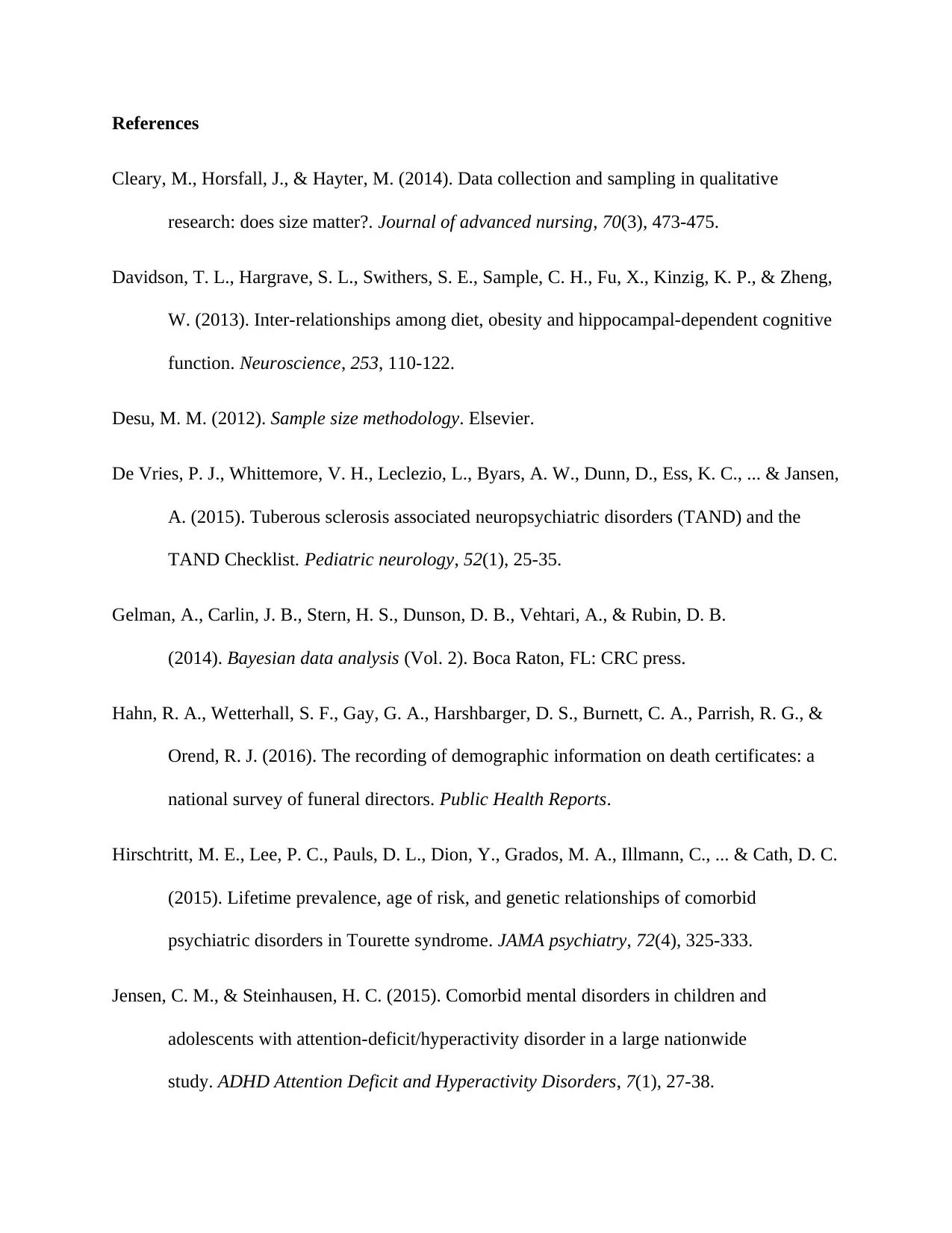
References
Cleary, M., Horsfall, J., & Hayter, M. (2014). Data collection and sampling in qualitative
research: does size matter?. Journal of advanced nursing, 70(3), 473-475.
Davidson, T. L., Hargrave, S. L., Swithers, S. E., Sample, C. H., Fu, X., Kinzig, K. P., & Zheng,
W. (2013). Inter-relationships among diet, obesity and hippocampal-dependent cognitive
function. Neuroscience, 253, 110-122.
Desu, M. M. (2012). Sample size methodology. Elsevier.
De Vries, P. J., Whittemore, V. H., Leclezio, L., Byars, A. W., Dunn, D., Ess, K. C., ... & Jansen,
A. (2015). Tuberous sclerosis associated neuropsychiatric disorders (TAND) and the
TAND Checklist. Pediatric neurology, 52(1), 25-35.
Gelman, A., Carlin, J. B., Stern, H. S., Dunson, D. B., Vehtari, A., & Rubin, D. B.
(2014). Bayesian data analysis (Vol. 2). Boca Raton, FL: CRC press.
Hahn, R. A., Wetterhall, S. F., Gay, G. A., Harshbarger, D. S., Burnett, C. A., Parrish, R. G., &
Orend, R. J. (2016). The recording of demographic information on death certificates: a
national survey of funeral directors. Public Health Reports.
Hirschtritt, M. E., Lee, P. C., Pauls, D. L., Dion, Y., Grados, M. A., Illmann, C., ... & Cath, D. C.
(2015). Lifetime prevalence, age of risk, and genetic relationships of comorbid
psychiatric disorders in Tourette syndrome. JAMA psychiatry, 72(4), 325-333.
Jensen, C. M., & Steinhausen, H. C. (2015). Comorbid mental disorders in children and
adolescents with attention-deficit/hyperactivity disorder in a large nationwide
study. ADHD Attention Deficit and Hyperactivity Disorders, 7(1), 27-38.
Cleary, M., Horsfall, J., & Hayter, M. (2014). Data collection and sampling in qualitative
research: does size matter?. Journal of advanced nursing, 70(3), 473-475.
Davidson, T. L., Hargrave, S. L., Swithers, S. E., Sample, C. H., Fu, X., Kinzig, K. P., & Zheng,
W. (2013). Inter-relationships among diet, obesity and hippocampal-dependent cognitive
function. Neuroscience, 253, 110-122.
Desu, M. M. (2012). Sample size methodology. Elsevier.
De Vries, P. J., Whittemore, V. H., Leclezio, L., Byars, A. W., Dunn, D., Ess, K. C., ... & Jansen,
A. (2015). Tuberous sclerosis associated neuropsychiatric disorders (TAND) and the
TAND Checklist. Pediatric neurology, 52(1), 25-35.
Gelman, A., Carlin, J. B., Stern, H. S., Dunson, D. B., Vehtari, A., & Rubin, D. B.
(2014). Bayesian data analysis (Vol. 2). Boca Raton, FL: CRC press.
Hahn, R. A., Wetterhall, S. F., Gay, G. A., Harshbarger, D. S., Burnett, C. A., Parrish, R. G., &
Orend, R. J. (2016). The recording of demographic information on death certificates: a
national survey of funeral directors. Public Health Reports.
Hirschtritt, M. E., Lee, P. C., Pauls, D. L., Dion, Y., Grados, M. A., Illmann, C., ... & Cath, D. C.
(2015). Lifetime prevalence, age of risk, and genetic relationships of comorbid
psychiatric disorders in Tourette syndrome. JAMA psychiatry, 72(4), 325-333.
Jensen, C. M., & Steinhausen, H. C. (2015). Comorbid mental disorders in children and
adolescents with attention-deficit/hyperactivity disorder in a large nationwide
study. ADHD Attention Deficit and Hyperactivity Disorders, 7(1), 27-38.
Paraphrase This Document
Need a fresh take? Get an instant paraphrase of this document with our AI Paraphraser
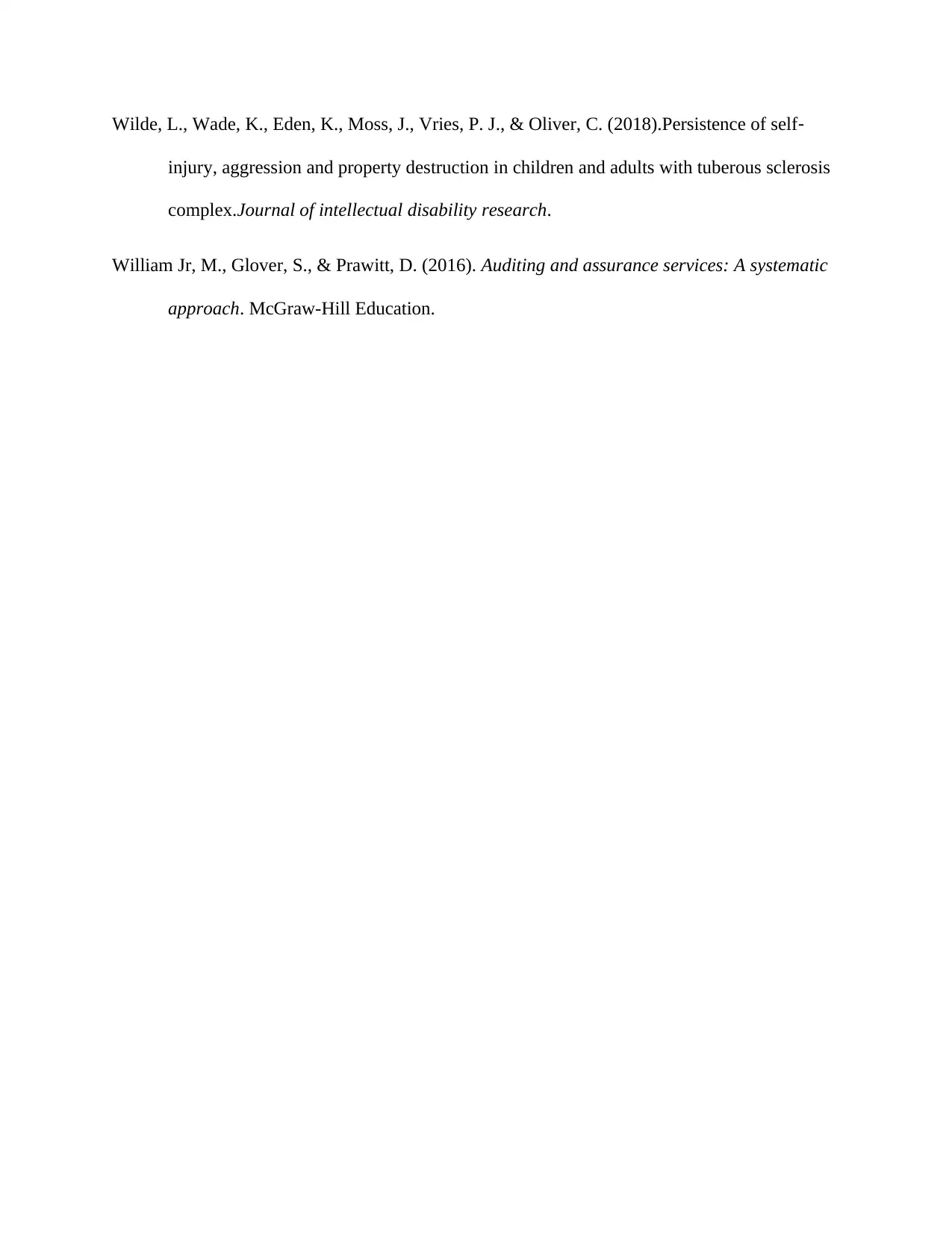
Wilde, L., Wade, K., Eden, K., Moss, J., Vries, P. J., & Oliver, C. (2018).Persistence of self‐
injury, aggression and property destruction in children and adults with tuberous sclerosis
complex.Journal of intellectual disability research.
William Jr, M., Glover, S., & Prawitt, D. (2016). Auditing and assurance services: A systematic
approach. McGraw-Hill Education.
injury, aggression and property destruction in children and adults with tuberous sclerosis
complex.Journal of intellectual disability research.
William Jr, M., Glover, S., & Prawitt, D. (2016). Auditing and assurance services: A systematic
approach. McGraw-Hill Education.
1 out of 11
Your All-in-One AI-Powered Toolkit for Academic Success.
+13062052269
info@desklib.com
Available 24*7 on WhatsApp / Email
![[object Object]](/_next/static/media/star-bottom.7253800d.svg)
Unlock your academic potential
Copyright © 2020–2025 A2Z Services. All Rights Reserved. Developed and managed by ZUCOL.
